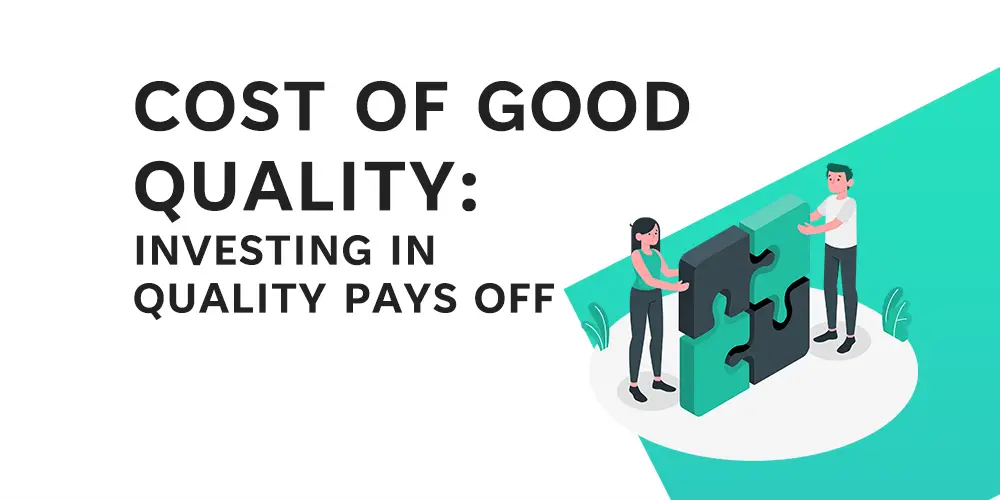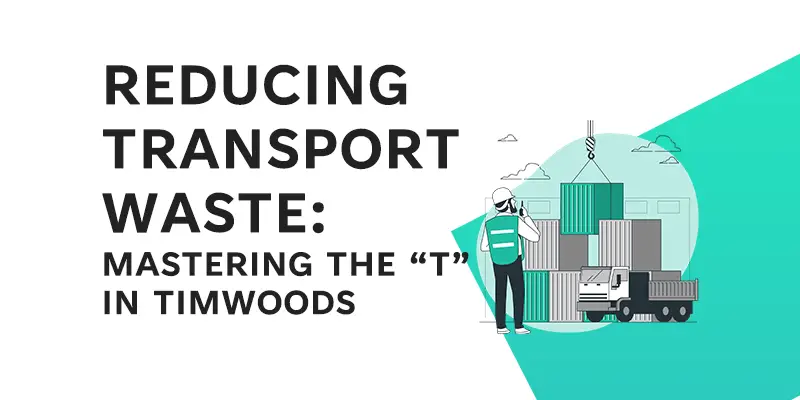Quality management is an essential component of any company that wishes to thrive in today’s competitive market. The Cost of Poor Quality (COPQ), which quantifies the cost of quality failures, is one of the key metrics that organisations use to measure the financial impact of quality. Many organisations, however, overlook the Cost of Good Quality (COGQ), which calculates the cost of quality success. Investing in quality can have a significant positive impact on an organization’s bottom line, and understanding the COGQ is critical for making informed quality investment decisions. In this blog post, we will look at the concept of the Cost of Good Quality, why it matters, and how businesses can benefit from quality investments.
Table of Contents
What is Cost of Quality
Cost of quality (COQ) is a concept used in quality management to describe the total cost incurred by an organization to ensure that its products or services meet customer requirements. COQ is often divided into two categories: Cost of Good Quality (COGQ) and Cost of Poor Quality (COPQ).
The cost incurred by an organisation to ensure that its products or services meet or exceed customer expectations is known as the Cost of Good Quality (COGQ). Once such method for improving quality in business is with Jidoka to implement systems, processes and visual management to improve quality control in a business. COGQ includes costs for prevention, evaluation, and training activities designed to keep defects from occurring in the first place. For example, a company may invest in employee training programmes or new technology to improve product design and reduce defects. The COGQ also includes costs for product inspection and testing to ensure that they meet quality standards. COGQ examples include:
- Preventive costs: The costs of preventing defects or problems from occurring. Quality planning, supplier evaluation, process improvement, and training are a few examples.
- Appraisal costs: The expenses incurred in evaluating products or services to ensure they meet quality standards. Inspections, testing, and audits are some examples.
- Training costs: The costs of educating employees about quality standards, quality improvement techniques, and other pertinent topics.
- Quality improvement costs: Costs associated with identifying and addressing quality issues. Corrective action, root cause analysis, and continuous improvement activities are some examples.
The Cost of Poor Quality (COPQ), on the other hand, is the cost incurred by an organisation as a result of defects and problems that arise during the production and delivery of products or services. These expenses can be divided into two categories: internal and external. Internal costs are those borne by the organisation, whereas external costs are those borne by the customer or society at large. COPQ examples include:
- Internal Failure Costs: The costs of defects discovered before the product or service is delivered to the customer. Scrap, rework, repair, and downtime are some examples.
- External Failure Costs: Costs incurred as a result of defects discovered by the customer or society after the product or service has been delivered. Warranty claims, product returns, customer complaints, and legal fees are some examples.
- Appraisal costs: The costs of detecting flaws. Inspection and testing are two examples.
- Prevention Costs: The costs of preventing defects from occurring. Quality planning, supplier evaluation, and process improvement are a few examples.
Why Does Cost of Good Quality Matter?
The Cost of Good Quality (COGQ) is a critical metric for determining the cost of producing high-quality products or services that meet or exceed customer expectations. Organizations that want to improve their quality, customer satisfaction, and overall business performance must invest in COGQ. Here are some of the reasons why the COGQ is important:
- Reduced Cost of Poor Quality (COPQ): Investing in COGQ can help reduce the cost of poor quality (COPQ) associated with defects, rework, and customer complaints. Organizations can reduce the need for costly corrective actions and improve overall productivity and efficiency by preventing defects from occurring in the first place.
- Improved Customer Satisfaction: High-quality products or services that meet or exceed customer expectations can lead to increased customer satisfaction and loyalty. Repeat business, positive word-of-mouth referrals, and a strong brand reputation can all result from this.
- Increased Efficiency: Investing in COGQ can increase production efficiency by reducing the time and resources required for inspection and rework. This can boost overall productivity while lowering production costs.
- Competitive Advantage: Organizations can gain a competitive advantage by producing high-quality products or services that differentiate them from competitors. This can result in increased market share, revenue, and profit.
- Regulatory Compliance: Many industries have strict regulatory requirements for quality control. Investing in COGQ can assist organisations in meeting these requirements while also avoiding costly fines and legal fees associated with non-compliance.
Lean Six Sigma Tools and Techniques used for COGQ
Lean Six Sigma offers a variety of tools and techniques for measuring and improving an organization’s cost of good quality (COGQ). Here are a couple of examples:
Process Mapping: Process mapping is a visual tool used to identify the steps and activities involved in a process. It is possible to identify areas where improvements can be made to increase the COGQ by mapping out the process.
Failure Mode and Effects Analysis (FMEA): FMEA is a risk management tool used to identify and assess potential failures in a process. An FMEA can be used to identify areas for improvement in order to raise the COGQ.
Statistical Process Control (SPC): SPC is a tool that uses statistical methods to monitor and control a process. It is possible to identify variations and make adjustments to maintain high COGQ levels by monitoring the process.
DOE (Design of Experiments): DOE is a tool for systematically testing and analysing the factors that influence a process. A DOE can be used to identify the best conditions for producing high-quality products.
Root Cause Analysis (RCA): Root Cause Analysis (RCA) is a problem-solving technique that identifies the underlying causes of defects or problems in a process. An RCA allows you to implement corrective actions to prevent future defects and improve COGQ.
Kaizen: Kaizen is a continuous improvement methodology that involves making small, incremental improvements to a process over time. Using Kaizen, it is possible to improve the COGQ by making small, long-term changes.
To summarise, Lean Six Sigma provides a variety of tools and techniques for measuring and improving COGQ in an organisation. Organizations can use these tools to identify areas for improvement, implement corrective actions, and maintain high levels of COGQ over time. Significant cost savings, increased customer satisfaction, and a stronger brand reputation can all result from this.
Real-life examples of cost of good quality (COGQ)
Real-life examples of cost of good quality (COGQ) being implemented in manufacturing businesses can help illustrate the benefits of investing in quality. Here are a couple of examples:
Toyota: Toyota has been a pioneer in implementing quality control techniques, such as Total Quality Management (TQM), to improve its production processes and reduce the cost of poor quality. The emphasis on COGQ is one of the key principles of TQM, which involves investing in quality upfront to prevent defects from occurring in the first place. This approach has helped Toyota achieve high levels of quality and customer satisfaction, propelling it to the top of the automotive industry.
Boeing: Boeing is another example of a manufacturing business that has implemented COGQ techniques to improve its operations. Boeing has concentrated on lowering the cost of rework and scrap in particular by investing in quality control measures and training its employees to identify and prevent defects. This has resulted in significant cost savings and increased production efficiency.
Apple: Apple is a well-known example of a company that has built its brand around high-quality products. Apple’s COGQ strategy entails heavily investing in R&D as well as quality control measures to ensure that its products meet or exceed customer expectations. This approach has assisted Apple in building a loyal customer base and maintaining its position as a technology industry leader.
Caterpillar: Caterpillar is a heavy equipment and machinery manufacturer that has used COGQ techniques to improve its operations. Caterpillar has concentrated on lowering the cost of warranty claims in particular by investing in quality control measures and training its employees to identify and prevent defects. As a result, significant cost savings have been realised, as well as increased customer satisfaction.
Nestle: Nestle is a global food and beverage company that has used COGQ techniques to improve product quality and lower the cost of poor quality. Nestle’s COGQ strategy includes investments in quality control measures and employee training to ensure that its products meet or exceed customer expectations. This strategy has assisted Nestle in maintaining a strong brand reputation and increasing customer loyalty.
Conclusion
In Conclusion, organisations that want to improve their business performance, increase customer satisfaction, and gain a competitive advantage must invest in quality. The cost of quality framework, which includes the cost of good quality (COGQ) and the cost of poor quality (COPQ), offers a structured approach for organisations to identify and address opportunities for improvement in their manufacturing processes.
Organizations that invest in COGQ can prevent defects from occurring in the first place, reduce the cost of rework and scrap, and improve overall operational efficiency. Significant cost savings, increased customer satisfaction, and a stronger brand reputation can all result from this.
Real-world examples of manufacturing companies that have implemented COGQ techniques demonstrate the advantages of investing in quality and the positive impact it can have on the bottom line. In conclusion, organisations that prioritise quality and invest in COGQ will be well-positioned to thrive in today’s competitive market.








